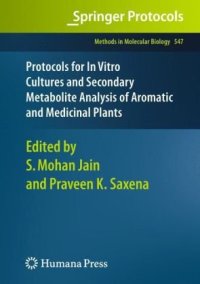
Ebook: Protocols for In Vitro Cultures and Secondary Metabolite Analysis of Aromatic and Medicinal Plants
- Genre: Biology // Plants: Botany
- Tags: Pharmacology/Toxicology, Plant Biochemistry, Cell Culture
- Series: Methods in Molecular Biology 547
- Year: 2009
- Publisher: Humana Press
- City: New York, NY
- Edition: 1
- Language: English
- pdf
Given the vital and far-reaching applications of medicinal plant metabolites worldwide, the quality and consistency of the products as well as the very survival of various species are of the utmost importance. In Protocols for In Vitro Cultures and Secondary Metabolite Analysis of Aromatic and Medicinal Plants, expert researchers provide detailed, step-by-step protocols for the establishment of in vitro cultures of key medicinal plants, their mass multiplication in a controlled environment, and step-wise secondary metabolite analysis, genetic transformation, large-scale metabolite production in a bioreactor, and molecular markers. In addition, many of these protocols will provide a basis for much needed efforts of in vitro germplasm conservation or cryopreservation of medicinal plant species at the brink of extinction as well as efforts to protect them from the adverse impact of rapid climatic changes. As a volume in the Methods in Molecular Biology™ series, chapters include introductions to their respective topics, lists of the necessary materials and reagents, readily reproducible laboratory protocols, and tips on troubleshooting and avoiding known pitfalls.
Comprehensive and authoritative, Protocols for In Vitro Cultures and Secondary Metabolite Analysis of Aromatic and Medicinal Plants is an ideal resource for scientists endeavoring to continue the research on this exciting natural branch of medicine.
This book contains 31 book chapters, divided into five sections. Section I contains 16 chapters describing step-wise protocols for micropropagation and chemical analysis of secondary compounds of different medicinal plants. Section II contains five chapters which address the transgenic approach for producing secondary metabolites. Section III contains two chapters which cover molecular markers/microsatellites. Section IV has six chapters which address biotransformation, bioreactors, and metablomics. Finally, section V contains two review chapters describing plant secondary metabolites in altered microgravity and role of biotechnology in producing anti-cancer compounds. Each chapter has been peer reviewed and revised accordingly.